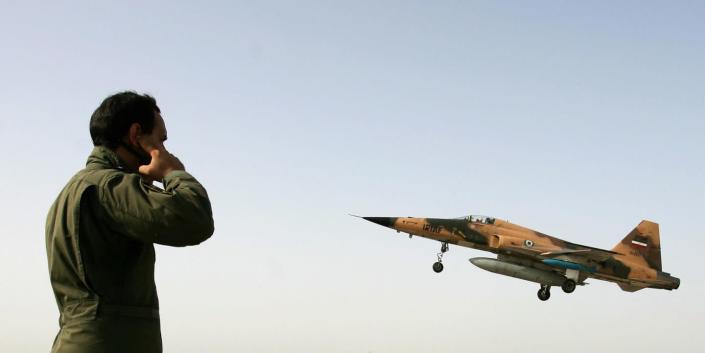
-
Iran’s air force has lost several jet fighters and trainers in the last three years.
-
The country, once swimming in American arms, has been cut off from modern weapons by arms embargoes until recently.
-
As a result, many of Tehran’s aircraft, particularly fighter jets, are almost a half-century old.
Iran is facing a ticking time bomb: its aging air force.
Several of the country’s fighters have crashed in recent years, with most of the incidents involving old, obsolete aircraft that other air forces around the globe have long since retired. Due to years of arms restrictions, the country has been relying on scores of jets purchased before the rise of Iran’s modern government—more than four decades ago.
✈︎ Don’t miss any of our best-in-class military and defense news. Join our squad.
Iran has lost at least five fighter jets since 2018, according to Forbes. Three of the crashes involved Northrop F-5E Tiger jets. An F-5 crashed in 2018, killing the pilot. In February 2022, another F-5 crashed, killing two more pilots. On May 25 of this year, another F-5 crashed in Isfahan province, killing both pilots.
The F-5s were part of a stream of military hardware purchased by the Shah, the autocratic ruler of Iran. The Shah, flush with hard currency from oil sales, purchased British tanks and ships; German rifles; and American fighter jets, tanks, and other armored vehicles to create what was, at the time, the most powerful military force in the Persian Gulf.


The problem? The Shah was forced from power in 1979, replaced by a theocratic, virulently anti-American regime. Defections and political purges internally gutted the Shah’s military before fighting an eight-year war against Iraq. Since the Iran-Iraq war ended in 1988, Tehran has operated under international arms embargoes and other restrictions in addition to economic woes, hobbling its ability to modernize its armed forces.
As a result, Iran’s fighter jet fleet is one of the oldest in the world. According to Flight International, the Islamic Republic of Iran Air Force (IRIAF) flies 199 fighter jets. Almost all of them date back to the 1970s, with just a handful of Russian-made MiGs acquired as recently as the early 1990s. American planes, including 63 F-4D/E and RF-4E Phantom fighters, 35 F-5E Tigers, and 41 F-4 Tomcats, still make up the bulk of the IRIAF’s fighter force, despite the fact that Iran’s current government cut ties with the United States in 1979.
U.S. fighter jets are among the most technologically advanced—and technically complex—in the world. Civilian employees loaned out from defense contractors often provide support to keep the planes flying, especially in the case of developing countries such as Iran in the 1970s. In 1979, after the change of government and a rise in anti-Americanism, defense contractors pulled their workers from Iran. Many foresaw the collapse of Iran’s air force as imminent.
That didn’t really happen. Iran has managed to keep a substantial number of aircraft flying, but at the price of slowly cannibalizing its fleet of planes. In 1973, Iran ordered 141 single-seat F-5E Tiger fighter jets. The F-5 Tiger was a single-seat, low-cost ($1.16 million) fighter exported in large numbers to friendly foreign air forces around the world. Long considered obsolete, most countries have retired it. A version of the fighter, the T-38C Talon jet trainer, still flies with the U.S. Air Force.


Iran may still be flying just one-sixth of its original Tigers, but that they’ve kept flying for nearly 50 years without new replacement parts and support from the original manufacturers is a herculean accomplishment. Iran has also attempted to smuggle F-5 parts from abroad, though it’s not clear how successful the smuggling campaign has been.
Although Iran has been successful in keeping its geriatric American planes flying, the recent rash of crashes is likely an age issue. Unlike larger planes—like the KC-135 Stratotanker and B-52 Stratofortress bomber, both of which are nearly 70 years old—the U.S. doesn’t fly any fighter jets that date to 1973. Fighter jets subject their airframes to more physical stress than larger airplanes, inducing metal fatigue on the airframe. The result is a shorter lifespan for fighters.


Two of Iran’s recent crashes involved F-5F fighters, the two-seat version of the jet used to train pilots for the single-seat F-5E. Iran purchased only 28 F-5Fs, and Flight International estimates only 14 are still flying as of late 2021. After the latest pair of crashes, that number is down to 12, reducing training opportunities for Iranian pilots for the F-5E and other fighters.
Iran needs new planes, and the international arms embargo that prevented it from buying new ones expired in October 2020. Despite this, Tehran has not rushed out to place orders for new warplanes, and it’s not clear why. What is clear is that Iran’s 20th-century air force will continue to fall out of the sky if the country doesn’t replace it with 21st-century jets. A half-century is much too long to fly a fighter jet, and Iran’s pilots are unfortunately paying the price.
You Might Also Like




